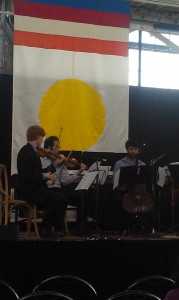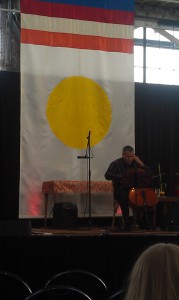Monday
Scene and HeardMusic as Transition
 Live Report from “Creating Enlightened Society”
Live Report from “Creating Enlightened Society”
by Leslie Gossett
Shambhala Times Reporter
Amidst the murmurs of the dispersed audience and the sounds of eating, drinking and talking, are the sounds of instruments floating through the large space. Everyone has wandered away from stage in search of dinner, and the imminent performance by the Friction Quartet is announced.
The Friction Quartet is a San Francisco Bay Area contemporary quartet, and their performance last night was quite a gift. The first piece was Buddhist Studies #1, composed by James Craft. It was composed specifically for the quartet to be performed at Creating Enlightened Society. The piece is “an expression of the yearnings, silence, and altogether human-ness found both in meditation and in the ancient traditions of Tibetan Buddhism,” James explains on his website, www.jamescraftmusic.com.
The piece opens with a haunting and solemn note which soon has the quartet dancing in a deep resonance. People are drawn closer to the stage. There is a quietness and depth pervading the sound. The sun is just starting to melt toward the horizon, so the glow that matches the music casts shadows slantwise upon our feet. I look around and people’s heads – now bodies – are swaying with the flow. I think of rolling waves washing me into space. The piece invokes a certain tenderness- a mirrored chord of longing that seems both familiar and primordial.
James writes, “as a composer, I try to bridge the gap between myself and the public by expressing what I think is meaningful.” Listening to the intimacy of his piece, I certainly felt that union.
The next piece performed by the Friction Quartet was Alex Van Gils’ The Water Which Flows Here. Alex composed this piece inspired by the text of the Sadhana of Mahamudra, a text written by Chogyam Trungpa Rinpoche. “The water which flows here is the Buddha Mamaki, who is the lake of the mirrorlike wisdom, clear and pure, as though the sky had melted,” Alex writes. The piece is dedicated to Sakyong Mipham Rinpoche.
As the music begins, one can sense the eagerness of the audience after hearing what the quartet is offering. In his introduction, Alex pointed out that the piece also contains elements of spikiness and violence, and the opening notes do have that spiky quality. There is both chaos and continuity. The arms, and bows, of the musicians move hastily – jerkily until a single soft note is reached and they are joined in a slow and sustained quiet precision. The feeling moves through softness and begins to gain strength. The bows turn into dancers gracefully gliding across the strings – asking questions of them, or making declarations perhaps. Player and played become one – the quality of intimacy touching my heart. Then the pace quickens – a liveliness and a surety emerges. I feel like I could cry. The music moves again, breathing, slow and deep, and then a light fluttering overtone. To watch the musicians is to see the utter embodiment of the music. They are so fully there – connected – exchanging glances as their bodies move, dip, sway, as if they are not four different people.
Alex has managed to express the tone, the feeling, the afterglow one experiences while practicing, and after having practiced the Sadhana of Mahamudra. The audience seems touched. The applause is strong and full of love.
When I asked Alex about his creative process, he read this to me, the words of Peter Lieberson, “The creative process is fundamentally a process of visualization: in the case of composing music, you see what you hear. Out of the space of mind something flashes — a first thought — that has potential. Further ideas occur as offshoots or main limbs through paying attention and through coincidence. Soon a form is before you that takes on a particular authority. Then sidetracks are out of the question.” One can sense this in the composition – the quality of clear creation.
The final piece performed by the Friction Quartet is a composition by Gabriella Smith called Riprap. I wasn’t able to find out from her the context or inspiration of the piece, but it certainly left an impression.
As the performance begins, a chorus is plucked that invokes rain drops, then the flow of tones takes over. I imagine a river winding in the dark, stumbling and slowing down in its flow. Then the drops quicken – louder now. The heads of the quartet players are bobbing up and down. And then the percussion begins (the quartet is joined by a marimba at this point). Scaly, sliding, sharp. I anticipate something. There is a poignancy, a pregnant sound. A sharpness slicing through slow movement, invoking curiosity. Then a haunting, drawing out. A brilliant resonance, and a cacophony. And finally a resolution, piercing and shining. A unified soaring. And the musicians draw out the final note, almost in agony.
The audience is moved, and ready for more.
 As Mark Summer, cellist from the Turtle Island Quartet, sets up on stage, I ponder the connection between music and enlightened society. This weekend has revolved around the idea that one moves from the personal to the communal and then to the societal in terms of transformation. Isn’t music just precisely the transition? From the personal to the communal, an offering is made. To play music in such a way as we are witnessing, requires a great deal of vulnerability and courage. There must exist some willingness to connect to something outside oneself, to extend oneself into the world. Listening and receiving that brings with it that same quality of opening. This is a pretty amazing foundation for relating to one another with compassion, wisdom, and dignity.
As Mark Summer, cellist from the Turtle Island Quartet, sets up on stage, I ponder the connection between music and enlightened society. This weekend has revolved around the idea that one moves from the personal to the communal and then to the societal in terms of transformation. Isn’t music just precisely the transition? From the personal to the communal, an offering is made. To play music in such a way as we are witnessing, requires a great deal of vulnerability and courage. There must exist some willingness to connect to something outside oneself, to extend oneself into the world. Listening and receiving that brings with it that same quality of opening. This is a pretty amazing foundation for relating to one another with compassion, wisdom, and dignity.
Mark embodies the joy that comes from that connection as he takes his seat on stage. One is immediately aware of the great joy he possesses at being there, at playing his cello. He smiles and moves with levity and grace. His performance is vibrant. He first plays “Julie-O,” a piece he wrote for his sister. One can sense the tenderness in its notes. Mark then offered tunes from Hendrix, the Beatles, and Paul Simon. As his set is closing, he expresses how honored he is to be “opening for the Sakyong.” “I will remember this,” he laughs, “until the day I die… or at least until tomorrow.” And before he leaves the stage to allow for preparations for the Sakyong’s evening address, he reminds us that it is in whatever we do – as a cellist, a lawyer, a doctor – that we must ask how we can contribute to the creation of an enlightened society.
With the lingering of inspiration and connection, the musical evening concluded, making way for more inquiry. How can we continue to touch in with the personal and offer it outward to the rest of our community?
~~
Click on each link to hear the sounds of the musicians: Friction Quartet, James Craft, Alex Van Gils, Gabriella Smith, and Mark Summer.
 Leslie Gossett is a student of all things human. She lives in Silicon Valley where she works with children, words, mind, and body
Leslie Gossett is a student of all things human. She lives in Silicon Valley where she works with children, words, mind, and body





May 15, 2013
Reply
Thank you!!
May 15, 2013
Reply
Hi There,
Just a quick note, it’s Mark Summer. No S at the end. It was wrongly spelled with the S in one place on the website and I’m sure that’s why the S is incorrectly added here. Thanks for the article. The music was great!
Cheers!